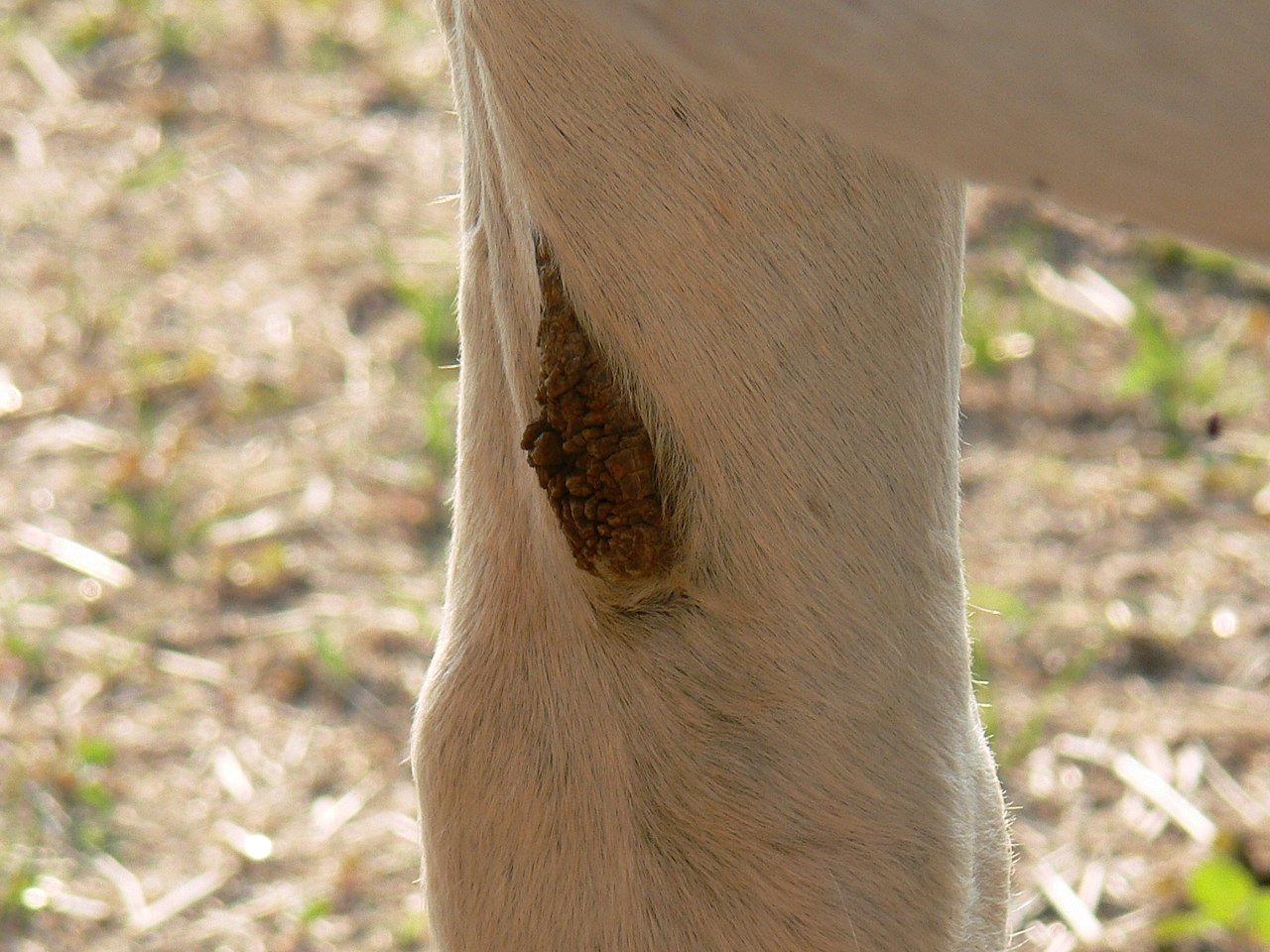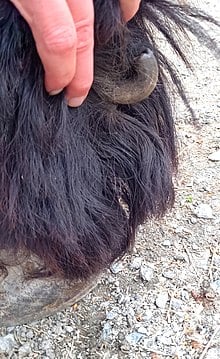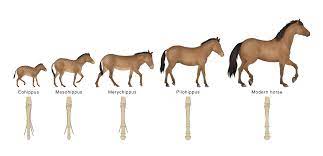What are Chestnuts on Horses?
Chestnuts on horses certainly aren’t pleasant to look at sometimes. And, if you don’t know exactly what you’re looking at, they might have you worried about your horse. But, there is no need to fear. Chestnuts on horses are completely harmless to them. Essentially, a chestnut on a horse is just a benign, hard flesh growth.
Why Do Horses Have Chestnuts?
 It’s commonly believed in the horse community that a chestnut on a horse tells a story of their evolution. The earliest prehistoric horses had functional toes. However, throughout time and the evolution of horses, horses lost their toes and developed only a single hoof to adapt to their climate and environment. Many scientists attribute chestnuts on horses to be remnants of the toes that they have lost throughout millions of years of evolution.
It’s commonly believed in the horse community that a chestnut on a horse tells a story of their evolution. The earliest prehistoric horses had functional toes. However, throughout time and the evolution of horses, horses lost their toes and developed only a single hoof to adapt to their climate and environment. Many scientists attribute chestnuts on horses to be remnants of the toes that they have lost throughout millions of years of evolution.
What is a Horse’s Chestnut Made of?
Horse chestnuts are formed from small deposits of keratin that gather on the horse’s leg. Chestnuts feel very oily and scaly to the touch, similarly to how a skin callus feels. Chestnuts on horses also don’t have any hair, so if your horse has a growth that has grown hair, it’s not a chestnut.
The Common Spot: Horse Chestnuts on Legs
Although it’s not known exactly why, a chestnut is typically found on a horse’s legs. In most cases, horse owners will spot a chestnut inside the horse's hind leg, or right above the knee on their front legs.
Sometimes, horse chestnuts on legs are referred to as “Night Eyes." The reasoning behind this is because it is believed that the chestnuts on their legs give them an ability to see in the dark.
Do Chestnuts Hurt Horses?
While chestnuts on horses are harmless, they can cause some sensitivity to your horse. It’s important to remember that while grooming or even riding, to pay special care to the area of the chestnut growth. Chestnuts on horses legs never stop growing, so while they don’t necessarily cause any pain to the horse, keep in mind that it could be uncomfortable for them.
Removing a Chestnut on a Horse
To avoid the issue of having to be cautious around the area of the chestnut growth, some horse owners make the decision to remove the chestnut altogether. Fortunately, it’s usually an easy enough process. Most chestnuts will peel off pretty easily and quickly, like a scab. It’s recommended to get your farrier to remove the chestnut from your horse for you, as they are professionals. This way, you can ensure that you won’t be causing any accidental harm or pain to your horse.
Remember, chestnuts on horses don’t have to be removed. They aren’t the prettiest aesthetically, but they aren’t hurting anything by being on your horse. If you’d rather just keep your horses chestnut growths at bay, you can also ask your farrier to keep them trimmed when they get their hooves trimmed.
Ergots vs. Chestnuts: What’s the Difference?
Drum roll, please…
When addressing the difference between ergots and chestnuts on horses, the consensus is: there isn’t very much of a difference. Ergots are the same hard, callus-like growth as chestnuts. The primary differentiator is that ergots are usually a little bit smaller than chestnuts, and they appear in a different location on the horse. The size of ergots range anywhere from the size of a pea to the size of a small bean. Ergots are normally found on the back of a horse’s fetlocks.
Can I Do Anything to Prevent Ergots and Chestnuts on My Horse?
In short, no. Although there are a lot of theories in the equestrian community about the causes of ergot and chestnut growth on horses, there is no scientific evidence to back them up. The 2011 article "Chestnut: Not Just a Coat Color," published by Kentucky Equine Research, indicates that the only cause of both ergots and chestnuts on horses is a vestigial reason. Vestigial means something has lost its function and/or purpose as part of the process of evolution.
The horse evolution process. Source: EquiVet Care Blog
The prehistoric horses known as the Eohippus had a much different leg structure, and also toes. As the horse breed evolved and went through different phases of evolving and adapting, their initial lower body makeup lost its purpose. Now, the remnants appear through the way of fleshy growths, that we know as chestnuts and ergots.
Should I Take My Horse to a Vet for an Ergot or Chestnut on Their Leg?
Both ergots and chestnuts typically do not require veterinary attention or any type of special care. The only time when it would be appropriate to seek out medical care for your horse surrounding an ergot or chestnut is if it’s causing any problems for your horse. A few signs to look out for:
-
Bleeding or pus from the area
-
Your horse reacts with pain when the area is touched
-
The area becomes moist or soggy in appearance
It’s understandable to want to run to the vet when you see a chestnut or ergot pop up on your beautiful horse. It’s a bit unsightly in comparison to their nice and shiny coat of hair. At the end of the day, you know your horse best. If a growth doesn’t look right to you, or it seems to be causing your horse any kind of problems, don’t hesitate to reach out for medical care.
But, if your horse seems completely unbothered - it’s normally best to just leave ergots and chestnuts alone. They certainly aren’t the prettiest thing to look at, but we like to think of them as something that makes your horse unique. They’re sometimes referred to as the fingerprint of a horse. All of our fingerprints are unique, and every horse that has a chestnut or ergot is also pretty special, too!
Special Care for Unique Features: Tailoring Horse Trailers for Chestnuts and Ergots
In the equestrian world, attention to detail is key, especially when it comes to unique physical traits like chestnuts and ergots on horses. These small, horn-like protrusions, found on the insides of their legs, require special consideration during transport.
Choosing Proper Horse Trailer Materials and Features for Horses with Chestnuts and Ergots
- Soft Padding in Key Areas: Ensure that areas around the trailer where a horse's legs might make contact are well-padded. This prevents irritation or injury to sensitive spots like chestnuts and ergots.
- Adjustable Partitions: Customizable partitions allow for the creation of a tailored space that accommodates horses of different sizes, ensuring that those with prominent chestnuts or ergots have enough room to stand comfortably without rubbing against hard surfaces.
- Gentle Loading Ramps: Steep or rough ramps can lead to horses scraping their legs, potentially harming areas where chestnuts and ergots are located. Ramps should be gentle and well-textured for easy and safe loading and unloading.
Maintaining Horse Health During Transport: The Role of Trailers in Protecting Sensitive Areas
Transporting horses is not just about moving them from one place to another; it's about ensuring their health and well-being throughout the journey. This is especially important for protecting sensitive areas like where chestnuts and ergots are located.
Key Trailer Features for Health Maintenance
- Superior Ventilation: Good air circulation is crucial for maintaining a healthy environment inside the trailer. It helps regulate temperature and reduces the build-up of moisture, which can be particularly bothersome around sensitive areas like chestnuts and ergots.
- Spacious and Stable Environment: Ample space allows horses to adjust their stance as needed for comfort and balance, reducing the risk of scrapes or pressure on sensitive parts. Stable flooring and a smooth ride are also essential to prevent unnecessary movement that could cause injury.
- Hygienic Conditions: Cleanliness in the trailer is paramount. Trailers should be easy to clean and disinfect, reducing the risk of infections, especially in areas where horses have protrusions like chestnuts and ergots.
Choosing the right horse trailer, equipped with features that cater to the health and comfort of the horse, is pivotal. It’s not just about getting horses to their destination; it’s about ensuring they arrive in peak condition, with particular attention to sensitive areas.



